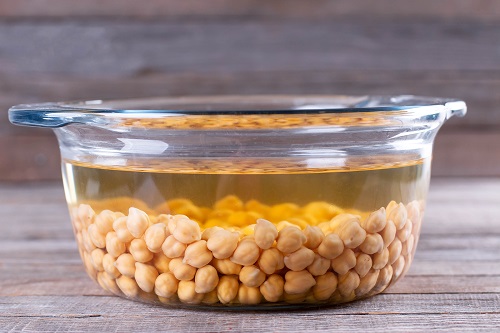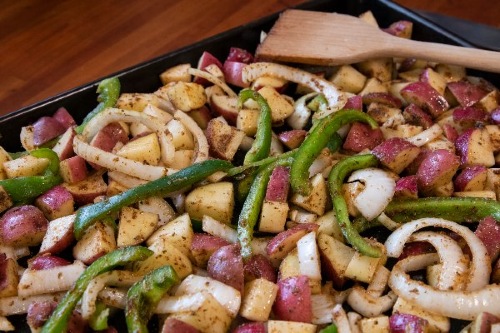This Food Talk Features blog highlights two delicious vegetable sub-groups: Beans, peas, and lentils and starchy vegetables! Keep reading to learn more about these unique veggies!
Each month this year, we are featuring a different food group or sub-group as part of our Food Talk Features… Series. Last month, we talked about dark green vegetables like broccoli and leafy greens. These veggies are fiber-filled for good digestion. They also contain folate, which helps our bodies make blood and prevents birth defects. Learn more about why we love dark green vegetables here!
This month, we’re diving into two more vegetable sub-groups: Beans, peas, and lentils and starchy vegetables! Other vegetable subgroups include:
- Red and orange vegetables
- Dark green vegetables
- And other vegetables. [1]
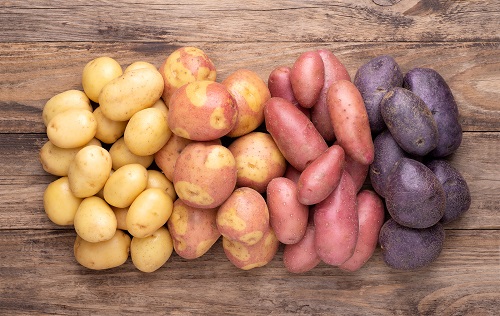
What are the benefits of these vegetable sub-groups?
Beans, Peas, and Lentils
Beans, peas, and lentils are a group of vegetables called “pulses.” They contain fiber and are a great source of plant-based protein. Beans, peas, and lentils are very helpful for people who do not eat meat. This is because they can count as a serving of protein when we eat plenty of other vegetables! [2]
The fiber in beans, peas, and lentils helps to lower cholesterol levels. This may reduce our risk of getting heart disease. Beans, peas, and lentils are a good source of folate, just like leafy green vegetables. Folate is needed for making blood and protects against birth defects. These veggies also contain antioxidants that support a strong immune system. [1] [3]

Examples of beans, peas, and lentils include:
- Beans like pinto, kidney, black, pink, garbanzo, soy, and mung beans
- Split, black-eyed, and pigeon peas
- Brown, black, red, and green lentils
- Foods made with beans, peas, and lentils (like bean burgers, falafel, tofu, and tempeh)
Green peas, lima beans, and string beans are not part of this veggie sub-group. This is because their nutrient content is closer to other types of vegetables. [4] [5]
Beans, peas, and lentils are a cheap way to get lots of nutrition! Dried versions are usually more affordable. After soaking in water, they are ready for cooking just like the canned versions. Remember that fresh, dried, canned, and frozen veggies are all nutritious ways to buy vegetables! [1]
We love this veggie sub-group so much that we have a blog all about it! Check out our All About Beans blog to learn how to prepare dried beans for cooking.
Starchy Vegetables
Some people think that starchy vegetables should be avoided, but this is not true. They are actually filled with nutrients! Like other vegetables, starchy veggies have lots of vitamins, minerals, fiber, and antioxidants. All of these things help prevent disease and promote a healthy heart. [6]
Foods in the starchy vegetable sub-group include:
- Corn (white and yellow)
- Green peas
- White potatoes and yams
- Cassava
- Jicama
- Plantains
- Yucca
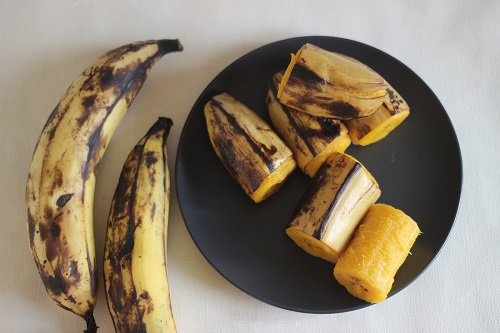
These foods are in the starchy veggie sub-group because they have similar nutrients. [5] Compared to other vegetable sub-groups, they also contain more carbohydrates per cup. This does not mean they need to be avoided! Instead, vary your veggies throughout the week so you get a good balance of nutrients.
Did you know that white potatoes are the vegetable that Americans eat the most? [7] White potatoes in particular contain potassium. This is a nutrient that many Americans need more of! [8] Potassium is important for keeping blood pressure in a healthy range. A healthy blood pressure also lowers our risk of heart disease and stroke. [9]
How much do I need?
The amount of vegetables we need every day depends on many factors. Most adults should aim for 1-3 cups of vegetables a day.
When it comes to measuring out portions of pulses and starchy vegetables, it’s easy! 1 cup of the food counts as a 1-cup-serving. For example, 1 cup of whole, mashed, or cooked lentils counts towards 1 cup of your daily vegetables. 1 medium white potato is also a 1-cup-serving.
Veggie sub-group suggestions are based on how much we should try to eat each week. Check out this table below to learn how many servings of beans, peas, and lentils and starchy veggies to aim for:
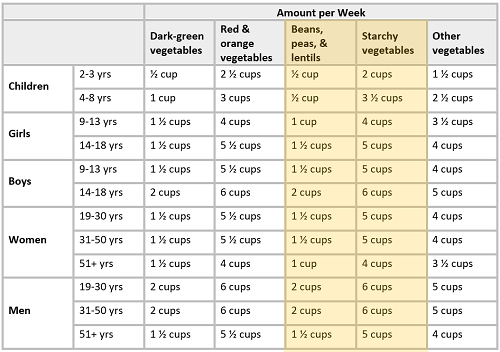
Table Source: Information from the 2020-2025 Dietary Guidelines for Americans
Beans, Peas, and Lentils (servings per week)
- Children (2-8 years old): ½ cup
- Girls (9-18 years old): 1-1 ½ cups
- Boys (9-18 years old): 1 ½ – 2 cups
- Women (19-50 years old): 1 ½ cups
- Women 51 years and above: 1 cup
- Men (19-50 years old): 2 cups
- Men 51 years and above: 1 ½ cups
Starchy Vegetables (servings per week)
- Children (2-8 years old): 2-3 ½ cups
- Girls (9-18 years old): 4-5 cups
- Boys (9-18 years old): 5-6 cups
- Women (19-50 years old): 5 cups
- Women 51 years and above: 4 cups
- Men (19-50 years old): 6 cups
- Men 51 years and above: 5 cups
Ways to Enjoy These Vegetable Sub-groups
We’ve shared our favorite recipes with beans, peas, and lentils in our All About Beans blog. Here are a few more delicious ones to try:
- For a plant-protein punch, make these Black Bean and Sweet Potato Veggie Burgers.
- Feeling adventurous? Try meatless soy crumbles (made from soybeans) in our Vegetarian Tacos with Homemade Salsa.
- Add Dirty Rice & Black-Eyed Peas to your side or main dish rotation!
- Appetizers like Southern Salsa and Greens and Beans Dip are sure to be a hit!
Most starchy vegetables are affordable and easy to keep on hand. Here are a few of our favorite ways to prepare starchy veggies:
- Let your crockpot do the work with this Slow-Cooker Potato, Corn, and Jalapeno Soup or Slow-Cooker Chicken and Dumplings
- Is using the oven more your thing? Try these Candied Yams, Sheet Pan Red Potatoes and Peppers, or make it a complete meal with our Sheet Pan Chicken and Vegetables.
- Go for this Fresh Corn Salad this summer!
Written by Melanie Ng, Ph.D. Candidate| Edited by Leslie Davis, MS, RDN, LDN, CDCES and the Nutrition Education Team
Posted: April 29, 2021
[2] MSU Extension- Vegetable Sub-groups
[3] U.S. Dry Beans- Bean Facts
[4] MyPlate- Beans, Peas, and Lentils are Unique foods
[5] MyPlate- Food Group Gallery
[6] Johns Hopkins- Starchy Vegetables
[7] USDA- Commonly Consumed Vegetables
